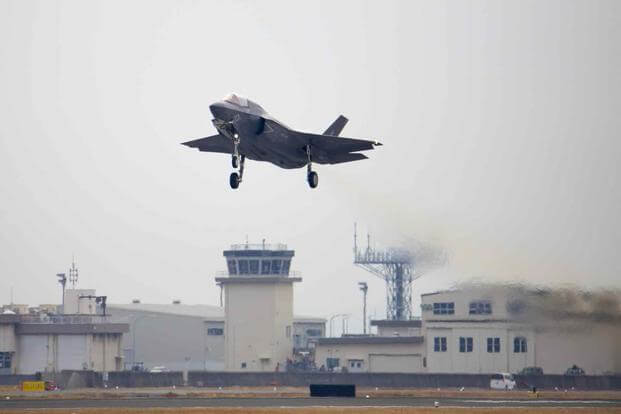A Marine Corps F-35B Lightning II's nose cone was damaged after making a quick landing in Okinawa, Japan, on Thursday, the service said.
Maj. Roberto Martins, a spokesman for 1st Marine Aircraft Wing, told Military.com in an emailed statement on Thursday night that the pilot was flying out of Marine Corps Air Station Iwakuni and had to make a "precautionary landing" at Kadena Air Base "due to a suspected electrical issue."
After touching down at the Air Force base's runway, the stealth fighter's landing gear failed while being towed to the flight line.
Read Next: Former Marine Sues VA, Alleging 'Years' of Discrimination Against Black Vets Seeking Benefits
"While being towed the front landing gear malfunctioned causing the nose of the aircraft to touch the ground," Martins said. "There are no injuries as a result of the landing gear malfunction, and a detailed investigation will be conducted."
Footage from Japanese public broadcaster NHK showed the F-35's nose dipped onto the runway and the front landing gear collapsed.
It's not yet clear what the electrical issues were, how much damage was done to the aircraft or what the cost will be to repair it.
So far, in 2022, the Marine Corps has reported a total of five Class A aircraft mishaps -- the classification the military uses for its most deadly and most expensive crashes. It's unclear what categorization Thursday's incident will receive.
The F-35 Lightning II was first cleared for use in training in 2012 and is flown by the Marine Corps, Air Force and the Navy. It is one of the most advanced aircrafts in the Pentagon's arsenal, possessing stealth technology for reconnaissance, intelligence and electronic warfare that have earned it the nickname "the flying computer." Some variants also have vertical takeoff and landing capabilities.
But the program has been criticized over the last decade by many in Washington for its high costs and frequent technical and mechanical issues.
A U.S. Government Accountability Office report earlier this year said that the Department of Defense currently has 450 F-35s and plans to have about 2,500 in total. But the F-35's mission-capable rate -- the percentage of time that the aircraft can fly and perform at least one mission -- declined between Fiscal Year 2020 and FY 2021 due to mechanical issues.
"One major reason is that an increasing number of F-35s have not been able to fly, because they don't have a working engine," the GAO report from April 28 said.
The landing gear mishap marks the most recent issue with an F-35 Lightning II variant this year.
In October, an F-35A Lightning II crashed at Hill Air Force Base in Utah, forcing the pilot to eject and causing wildfires on the base.
In late July, Air Combat Command stood-down its fleet of F-35As after a recall related to the aircraft's ejection seats worried officials. By mid-August, the fighter jets were back in the air.
-- Thomas Novelly can be reached at thomas.novelly@military.com. Follow him on Twitter @TomNovelly.
Related: F-35 Crashes in Utah During Training Mission; Pilot Ejects Safely













